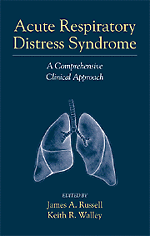Book contents
- Frontmatter
- Contributors
- Contents
- Preface
- Introduction
- 1 Overview, Clinical Evaluation, and Chest Radiology of ARDS
- 2 The Epidemiology of ARDS
- 3 The Pathology of ARDS
- 4 Cytokine -Induced Mechanisms of Acute Lung Injury Leading to ARDS
- 5 Pulmonary Pathophysiohgy in ARDS
- 6 Cardiovascular Management of ARDS
- 7 Mechanical Ventilation
- 8 Respiratory Muscles and Liberation from Mechanical Ventilation
- 9 Clinical Assessment and Total Patient Care
- 10 ARDS: Innovative Therapy
- 11 Nosocomial Pneumonia in ARDS
- 12 Resolution and Repair of Acute Lung Injury
- 13 Multiple System Organ Failure
- 14 Outcome and Long-Term Care of ARDS
- Index
1 - Overview, Clinical Evaluation, and Chest Radiology of ARDS
Published online by Cambridge University Press: 05 October 2010
- Frontmatter
- Contributors
- Contents
- Preface
- Introduction
- 1 Overview, Clinical Evaluation, and Chest Radiology of ARDS
- 2 The Epidemiology of ARDS
- 3 The Pathology of ARDS
- 4 Cytokine -Induced Mechanisms of Acute Lung Injury Leading to ARDS
- 5 Pulmonary Pathophysiohgy in ARDS
- 6 Cardiovascular Management of ARDS
- 7 Mechanical Ventilation
- 8 Respiratory Muscles and Liberation from Mechanical Ventilation
- 9 Clinical Assessment and Total Patient Care
- 10 ARDS: Innovative Therapy
- 11 Nosocomial Pneumonia in ARDS
- 12 Resolution and Repair of Acute Lung Injury
- 13 Multiple System Organ Failure
- 14 Outcome and Long-Term Care of ARDS
- Index
Summary
Introduction
The acute respiratory distress syndrome is a relatively new disease that emerged as intensive care units developed. Before mechanical ventilation and ICUs existed, most patients with moderate or severe ARDS would have died. In this chapter we present an overview of ARDS and introduce other concepts dealt with in detail in subsequent chapters. For example, epidemiology is touched on here but is presented in much greater detail in Chapter 2. This overview chapter is also intended to be a stand-alone review of ARDS from a clinically oriented perspective. That is, we have tried to include the most important clinical concepts, present an approach to evaluating and managing the patient, and focus on chest radiology as an integral component of this process.
Definition
Acute lung injury associated with increased capillary-alveolar permeability has been termed the acute respiratory distress syndrome (ARDS). ARDS has many causes. The onset of ARDS is acute, and the duration is usually days to weeks. The clinical hallmarks of ARDS are hypoxemia, reduced lung compliance, diffuse bilateral pulmonary infiltrates on chest radiograph, and need for mechanical ventilation. Since its initial description in 1967, the criteria for defining ARDS have changed. Normal left ventricular (LV) filling pressures (i.e., PCWP < 18 mmHg) and the presence of a risk factor were added as inclusion criteria after introduction of pulmonary artery catheters and after better understanding of the epidemiology of ARDS, respectively.
- Type
- Chapter
- Information
- Acute Respiratory Distress SyndromeA Comprehensive Clinical Approach, pp. 6 - 27Publisher: Cambridge University PressPrint publication year: 1999



